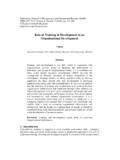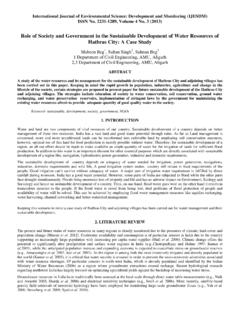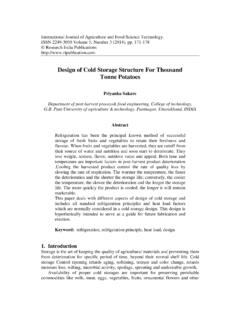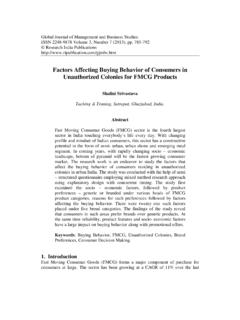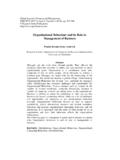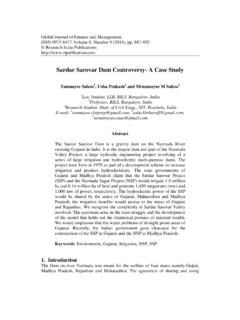Transcription of Multipath Fading Channel Modeling and Performance ...
1 International Journal of Electronics and Communication Engineering. ISSN 0974-2166 Volume 4, Number 2 (2011), pp. 189-203 International Research Publication House Multipath Fading Channel Modeling and Performance Comparison of Wireless Channel Models Chavan1, Chile2 and Sawant3 1 Department of Electronics and Telecommunication Engineering, Budhgaon, Sangli, India 2 Department of Instrumentation Engineering, College of Engineering Nanded, India 3 Department of Science and Technology, Shivaji University, Kolhapur, India Abstract In this paper, we have proposed Multipath Fading Channel simulation model for wireless communication.
2 We have tested the model for sine wave and complex wave inputs. The effects of noise on Fading and scattering property of the Channel were tested. The results show that the BER Performance is improved dramatically in low SNR than in high SNR. This is reasonable since at low SNR, white Gaussian noise dominate the BER error which can be improved by enhancing SNR while in high SNR, phase estimation error dominate the BER error which cannot be improved simply enhancing SNR. Next we have tested, analyzed and compared the Performance of the Channel models. The more accurate model is Rayleigh model which can be considered for developing Multipath Fading Channel model.
3 Keywords: Channel models, Fading channels, Rayleigh Fading , AWGN Channel , Rician model. Introduction The wireless industry has developed and deployed an infrastructure for providing many services for the users. The design, production and deployment of such technological infrastructure have high cost therefore manufacturers search for different alternatives to avoid high costs. One of these alternatives is simulating a real wireless system. The advantage of simulation is that allows less expensive testing of 190 Chavan et al designs. In this paper we have simulated and tested Multipath Fading Channel model for wireless communication.
4 There has been significant research activity over the past 5-15 years into the Performance of wireless Channel models. In wireless transmission system where a receiver is in motion relative to a transmitter with no line-of-sight path between their antennas the Rayleigh Fading is a good approximation of realistic Channel conditions [1]. The term Rayleigh Fading Channel refers to a multiplicative distortion h(t) of the transmitted signal s(t), as in y(t) = h(t) s(t)+ n(t), where y(t) is the received waveform and n(t) is the noise[1]. Zhifeng Chen has build up a wireless communication simulator including Gray coding modulation, different Channel models (AWGN, flat Fading and frequency selective Fading channels), Channel estimation, adaptive equalization, and demodulation [2].
5 He has tested the effect of different Channel models to the data and image in receiver with constellation and BER (bit error rate) plots under QPSK modulation. Chengshan Xiao, Yahong Rosa Zheng, and Norman C. Beaulieu were analyzed the statistical properties of Clarke s Fading model with a finite number of sinusoids and an improved reference model is proposed for the simulation of Rayleigh Fading channels [13]. Yahong Rosa Zheng and Chengshan Xiao proposed new sum-of-sinusoids statistical simulation models are proposed for Rayleigh Fading channels [15]. We have proposed Multipath Fading Channel simulation model in which the effect of a propagation environment on a radio signal such as signal strength variations, phase shift variations in the signal and additive noise has been considered.
6 The model is given by y(t) = g1 s (t) + [ g2 s (t)] + [ g2 s (t)] + n (t) Where, y (t) is output signal , s (t) is input signal , is delay or phase shift, g1 is fixed gain, g2 is variable gain and n (t) is noise. We have tested Multipath Fading Channel simulation model for sine wave and complex wave inputs. The effects of noise on Fading and scattering property of the Channel have been tested. We have also tested, analyzed and compared the BER Performance of Rayleigh Channel model, AWGN Channel Model and Rician Channel models and it has been observed that more accurate model is Rayleigh Channel model because its BER curves have steepness and values more closely to theoretical analysis.
7 The proposed Multipath Fading Channel simulation model also provides similar Performance . The Channel model can be used to test the Performance of radios in a mobile environment. Fading and Fading Channel models The wireless environment is highly unstable and Fading is due to Multipath propagation. Multipath propagation leads to rapid fluctuations of the phase and amplitude of the signal . The presence of reflectors in the environment surrounding a transmitter and receiver create multiple paths that a transmitted signal can traverse. As a result, the receiver sees the superposition of multiple copies of the transmitted signal , each traversing a different path.
8 Each signal copy will experience differences in attenuation, delay and phase shift while traveling from the source to the receiver. Multipath Fading Channel Modeling 191 This can result in either constructive or destructive interference, amplifying or attenuating the signal power seen at the receiver. Fading may be large scale Fading or small scale Fading [9]. Based on Multipath time delay spread small scale Fading is classified as flat Fading and frequency selective Fading .
9 If bandwidth of the signal is smaller than bandwidth of the Channel and delay spread is smaller than relative symbol period then flat Fading occurs whereas if bandwidth of the signal is greater than bandwidth of the Channel and delay spread is greater than relative symbol period then frequency selective Fading occurs. Based on doppler spread small scale Fading may be fast Fading or slow Fading . Slow Fading occurs when the coherence time of the Channel is larger relative to the delay constraint of the Channel . The amplitude and phase change imposed by the Channel can be considered roughly constant over the period of use.
10 Slow Fading can be caused by events such as shadowing, where a large obstruction such as a hill or large building comes in the main signal path between the transmitter and the receiver. Fast Fading occurs when the coherence time of the Channel is small relative to the delay constraint of the Channel . The amplitude and phase change imposed by the Channel varies considerably over the period of use. In a fast- Fading Channel , the transmitter may take advantage of the variations in the Channel conditions using time diversity to help increase robustness of the communication.
